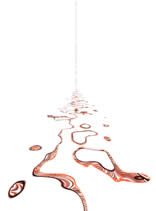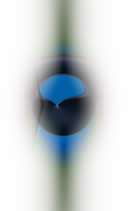Films with Significant Electroacoustic Content
The following list began as a discussion on (now cec-conference) instigated by Ian Chuprun in late October 2002. A brief list of “significant” or commonly available films resulted, and for eContact! 8.4 the list was considerably expanded.
Films made after approximately 1980 commonly use electronic soundtracks in various forms, and are therefore, because of the sheer numbers, only listed when special emphasis, or artistry are present in the electronics, or when they relate to electroacoustic personalities.

1920 | 1930 | 1940 | 1950 | 1960 | 1970 | 1980 | 1990 | 2000
Documentaries | Contributors | Contribute a new entry
1920
Ballet Mécanique (1924). Dir. Fernand Léger and Dudley Murphy; music by George Antheil.
Though not actually an electronic score, this film is a significant antecedent. Machines and electric buzzers are featured.
Various works. Oskar Fischinger.
1930
Romance Sentimentale (1930). Dir. Sergei Eisenstein and Grigori Alexandrov.
This short develops Eisenstein’s theory of contrapuntal sound, and parts of the soundtrack were drawn directly onto the film’s optical track — among the first examples of “hand-drawn” or “animated” sound.
Love on the Wing (1939). Dir. Norman McLaren; music by McLaren.
McLaren’s first experiment with “animated sound”, which for this film was made without the use of a microphone; rather, the percussive rhythms were made by drawing small strokes and blobs on the side of the film where the soundtrack is found.
In addition to McLaren’s pioneering work in what was essentially one of the first general purpose synthesis systems (he developed tuning, timber and dynamic systems for his optical film etching) other animators at the National Film Board (of Canada: NFB/ONF) worked directly with theoptical track. As one example Pierre Hébert of Living Cinema fame did some fabulous films in the sixties that demonstrate this.
1940
The Lost Weekend (1945). Dir. Billy Wilder; music by Miklós Rózsa.
Use of theremin.
Spellbound (1945). Dir. Alfred Hitchcock; music by Miklós Rózsa.
Use of theremin in the dream sequence designed by Dali.
The Spiral Staircase (1946). Dir. Robert Siodmak; music by Robert Webb.
Soundtrack makes use of theremin, performed by Samuel Hoffman.
1950
The Day the Earth Stood Still (1951). Dir. Robert Wise; Music by Bernard Herrmann.
Dr. Samuel Hoffman and Paul Shure play theremin.
Les vacances de Monsieur Hulot (1953). Dir. Jacques Tati.
Although no electronic sounds are used (aside from those which are part of the film’s dramaturgy, such as loudspeakers etc.), this could be seen as an early example of sound design in film. Tati often made use of exaggerated sonic effects in his films, individual sounds are disproportionately loud compared to their “proper” levels. “His soundtracks abandon the illusion of naturalism in favor of abstract collages of noises.... In Mr. Hulot’s Holiday a tennis ball makes an audible popping sound as it bounces off the head of a young girl in the middle of curtsying” (frenchculture.org).
Forbidden Planet (1956). Dir. Fred M. Wilcox; music by Bebe and Louis Barron.
This film includes the first instance that a totally electronic music score had been used for a big(ger) budget commercially-released film.
Dom (1957). Dir. Jan Lenica and Walerian Borowczyk, music by Wlodzimierz Kotonski.
Short film.
Schwechater (1958). Dir. Peter Kubelka.
Kubelka’s short, made from monochrome frames of film, matches coloured frames with sine tone blips.
Les Astronautes (1959). Dir. Walerian Borowczyk and Chris Marker; music by Andrzej Markowski.
Borowczyk’s surrealist, dialogue-free short features an energetic electroacoustic soundtrack combining instrumental sonorities with prominent use of oscillators. Interestingly, diegetic elements of sound design frequently mutate into non-diegetic soundtrack music elements.
1960
Arnulf Rainer (1960). Dir. Peter Kubelka.
Kubelka’s short consists of white and black frames only, the white paired with white noise, and the black with silence.
La Poupee (1962). Dir. Jacques Baratier; music contributions by Bernard Parmegiani.
No Exit (1962). Dir. Tad Danielewski and Orson Welles; music by Vladimir Ussachevsky.
The Birds (1963). Dir. Alfred Hitchcock.
Soundtrack consists entirely of dialogue and electronically-created bird sounds — there is no music, per se. It is believed that for the soundtrack Hitchcock used Oskar Sala’s Mixturtrautonium — his live performance version of the earlier Trautonium from the 1920s.
Les Jeux des Anges (1964). Dir. Walerian Borowczyk; music by Bernard Parmegiani.
Short film.
Kwaidan (1964). Dir. Masaki Kobayashi; music by Tôru Takemitsu.
Takemitsu and his musicians mangled pieces of wood to create the electronic sounds. (Also see Bibliography: Film and Electronics)

The Saragossa Manuscript (1965). Dir. Wojciech Has; electroacoustic soundtrack by Krzysztof Penderecki.
Le Dictionnaire de Joachim (1965). Dir. Walerian Borowczyk; music by Bernard Parmegiani.
Short film.
A (1965). Dir. Jan Lenica; music by Bernard Parmegiani.
Short film.
Wavelength (1967). Dir. Michael Snow.
One slow, 45-minute zoom is accompanied by a single slowly ascending sine wave.
Line of Apogee (1968). Dir. Lloyd Williams; music by Vladimir Ussachevsky.
1970
Andromeda Strain (1971). Dir. Robert Wise; Entirely electronic score by Gil Melle. (sometimes Mellé).
Melle dismissed the Barron’s work in Forbidden Planet as merely noises and claimed that his score was the first entirely electronic one for film. This film represents something of a landmark in any case if only as an example of a score entirely composed and produced by a single person.
Clockwork Orange (1971). Dir. Stanley Kubrik.
Solyaris (1972) aka Solaris. Dir. Andrei Tarkovsky; music by Eduard Artemev.
Dark Star (1974). Dir. John Carpenter; music by Carpenter.
Carpenter composed music for most of his films (40 titles in the IMDb credit him as composer). His early works were entirely electronic, notably this film.
Ignacio (1975) English title Do you hear the dogs barking? Dir. François Reichenbach; music by Vangelis.
Sorcerer (1975) aka Wages of Fear. Dir. William Friedkin; music by Tangerine Dream.
Zerkalo (1975) aka Mirror. Dir. Andrei Tarkovsky; music by Eduard Artemev.
Eraserhead (1977). Dir. David Lynch; Music by Lynch.
The Shout (1978). Dir. Jerzy Skolimowski.
Features the main character (John Hurt) as hero/anti-hero and electronic composer, using an EMS. High profile use of electroacoustics as part of the plot, not just soundtrack. The Shout does with sound something akin to what Hideo Nakata’s Japanese horror Ring did with video, twenty years later — the plot revolves around a mysterious ‘terror shout’ which can kill all that hear it. John Hurt’s character is a composer who spends part of the film working in an electroacoustic music studio.
Alien (1979). Dir. Ridley Scott; music by Jerry Goldsmith.
Goldsmith used real-time analogue synthesis in the recording sessions with the synthesizers amplified in the studio. That way the synth players performing with the orchestra and the conductor (Goldsmith) heard the work in its entirety during the recording session.
Stalker (1979). Dir. Andrei Tarkovsky; music by Eduard Artemev.
1980
Thief (1980). Dir. Michael Mann; music by Tangerine Dream.
Tangerine Dream’s “big break”. Electronic scores were de rigueur after that, of course.
Blow Out (1981). Dir. Brian De Palma.
De Palma’s thriller is a loose reworking of Antonioni’s Blow Up, featuring a sound recordist in place of a photographer. While it has little to do with electroacoustic composition per se, the plot revolves around analysis of a sound recording: John Travolta’s character believes he may have captured sonic clues to an assassination while doing location recordings for a film.
Chariots of Fire (1981). Dir. Hugh Hudson; music by Vangelis.
Vangelis’ first mainstream film score.
Blade Runner (1982). Dir. Ridley Scott; music by Vangelis.
Docteur Jekyll et les Femmes (1983). Dir. Walerian Borowczyk, music by Bernard Parmegiani.
Feature film.
Risky Business (1983). Dir. Paul Brickman; music by Tangerine Dream.
Timbres and gestures really don’t work for this teen comedy, starring Tom Cruise.
Legend (1985). Dir. Ridley Scott; original music by Tangerine Dream.
Also released with a more conventional score by Jerry Goldsmith.
Family Viewing (1987). Dir. Atom Egoyan; music by Mychael Danna.
Mostly electronic score.
Near Dark (1987). Dir. Katherine Bigelow; music by Tangerine Dream.
Another excellent and creepy example (vampires roaming the midwestern US in a RV with blacked out windows...) of electronic music/sounds being used in films about “the other”.
Scherzo Infernal (1987). Dir. Walerian Borowczyk, music by Bernard Parmegiani.
Short film.
1990
Das Goldene Tor (1992). Dir. Jurgen Reble; music by Thomas Koner.
Eldorado (1995). Dir. Charles Binamé; music by Francis Dhomont.
Chicago (1996). Dir. Jurgen Reble; music by Thomas Koner.
Short film.
π (Pi) (1998). Dir. Darren Aronofsky; Sound design by Brian Emrich.
Heavy use of electronic sounds when the main character has another one of his “crisis”.
2000
La beauté de Pandore (2000). Dir. Charles Binamé; music by Ned Bouhalassa.
Extracts of Bouhalassa’s 1998 CD Aérosol (empreintes DIGITALes) are included in the film.
In Absentia (2000). Dir. Stephen and Timothy Quay; music by Karlheinz Stockhausen.
Short film.
Film Ist (2002). Dir. Gustav Deutsch; music by Fennesz, Martin Siewert and Burkhard Stangl.
Solaris (2002). Dir. Steven Soderbergh; music by Cliff Martinez.
Elephant (2003). Dir. Gus Van Sant; music by Hildegard Westerkamp.
Includes parts of two works by Westerkamp, Beneath the Forest Floor and Turen der Wahrnehmung.
Welt Spiegel Kino (2005). Dir. Gustav Deutsch; music by Fennesz and Burkhard Stangl.
Documentaries (film, video and TV)
Theremin: An Electronic Odyssey (1994). Dir. Steven M. Martin.
“A documentary about the inventor of the first electronic synthesiser instrument and his subsequent life after he was abducted by the KGB as well as a history of his instrument” (IMDb). Overview of theremin use in film and music.
Music for the Movies (1995). Dir. Charlotte Zwerin. 118 min. ASIN: 6303824528. VIDEO.
“A documentary of the Japanese film composer Toru Takemitsu, featuring interviews and clips from films he scored” (IMDb).
References
IMDb — The Internet Movie Database. http://imdb.com
The iotaCenter. Oskar Fischinger biography. http://www.iotacenter.org/search?SearchableText=fischinger. Accessed 3 August 2006.
French Culture http://www.frenchculture.org/cinema/festival/tati/index.html. Accessed 31 October 2002.
Keane, David. ‘Electroacoustic Music in Canada: 1950–1984’, in eContact! 3.4 — Histoires de l’électroacoustique / Histories of Electroacoustics.
UBU web. http://ubu.com
Wikipedia. http://en.wikipedia.org
Composer / Sound Artist websites
George Antheil
Ned Bouhalassa
Francis Dhomont
Bernard Parmegiani. Information on various Parmegiani soundtracks can be found at http://neospheres.free.fr/electro/parmegiani.htm.
Karlheinz Stockhausen
Tangerine Dream
Contributors
Dennis Bathory-Kitsz
Steve Benner
Ned Bouhalassa
Kevin Busby
jef chippewa
Ian Chuprun
Martin Gotfrit
Howard Harawitz
Elizabeth Hinkle-Turner
Doug Keislar
Dennis Miller
Javier Ruiz
Pete Stollery
Coryn Smethurst
Ian Stewart
Richard Zvonar
Contribute a New Entry
If you wish to add an entry to the list, or add an annotation to an existing entry, contact jef chippewa. Please include the following information:
FilmName (YEAR). Dir. NAME; music by ComposerName.
Brief description (20–40 words) of electroacoustic content, specifically how it relates to the film.
Social top